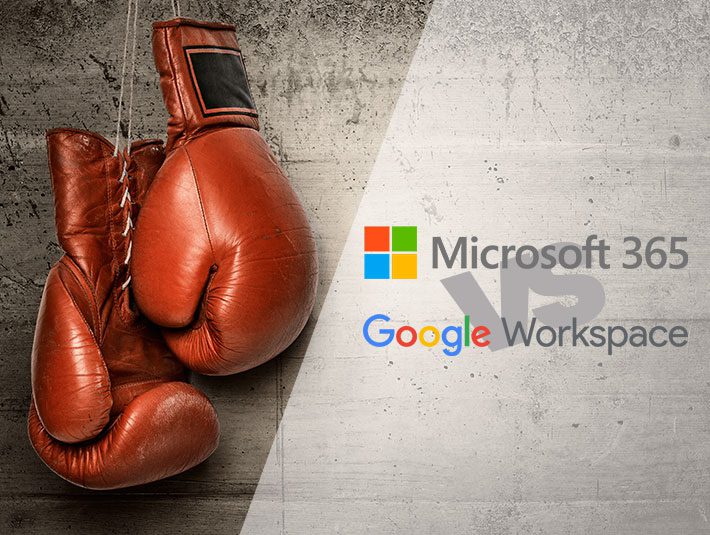No matter what kind of business you’re running, there’s a good chance some of your team members need tools to work better.
We used to call this an office suite, and Microsoft Office was the only option. However, the concept has become more advanced over the past decade due to cloud-based technology. Cloud services have taken the lead, and businesses focused on office work have been enjoying better collaborative features.
The choice comes down to Microsoft 365 or Google Workspace. These solutions pack quite a punch, with many features and powerful capabilities. But how are they different?
In this guide, we’re going to walk you through the most significant differences between the two across several categories:
- Ease of use
- Collaboration
- Storage
- Security and Support
- Pricing
We aim to show you why Microsoft 365 is the right choice for your business. As a Microsoft 365 expert, we’re ready to help you set up the platform and educate your team on using the various tools within this robust ecosystem.
But before we dive into the details, let’s start with the basics.
The Basics
Microsoft 365 is the evolution of Office, packing all the familiar apps you’ve come to know and rely on, like Microsoft Word, Excel, Outlook, PowerPoint, OneDrive, and Exchange. It also includes powerful, modern tools such as Teams and SharePoint and many smaller tools that add value to some organizations.
Google Workspace is Google’s take on a cloud-first alternative to Microsoft 365. It comes with similar products, including Docs, Sheets, Slides, Keep, Drive, and Calendar. To compete with Teams and SharePoint, Google offers Meet and Sites.
Both platforms allow you to tackle most of the same tasks, but each has quirks and qualities. Google typically provides more lightweight, streamlined apps, while Microsoft offers a greater depth of functionality and formatting.
One significant distinction is that Google’s suite is primarily cloud-based. There’s no desktop Docs app; the same goes for Sheets, Slides, and Gmail. You also won’t save your files to a local network – everything is stored in the cloud. This approach offers tremendous flexibility but can be limiting in some cases.
In recent years, Microsoft has released web-based versions of all its powerful tools and invested heavily in creating a robust, mature cloud-based experience. Features like conditional access policies, share permissions, multifactor authentication, folder sync, and device compatibility give Microsoft an edge. With Microsoft 365, you can operate in the cloud using browser-based versions of all its tools while still having the option to work locally with desktop and mobile apps.
Ease of Use
Real-life usage is where the two platforms show more differences. It’s not about being way easier to learn and use than the other; it’s more about the unique experience.
Microsoft 365. Microsoft is the big kahuna here. Almost every office worker on the planet is familiar with its products. Microsoft might have a steeper learning curve for new users, but that’s because its apps come with more features than Google’s alternatives.
Microsoft has some growing to do, though. Its collaborative tools (where multiple users can edit a document simultaneously) are potent but less mature and more complex when dealing with network-based documents. Google’s collaboration features just work, almost always.
For businesses that want to keep a traditional file structure (or a cloud-based equivalent), Microsoft 365 takes the cake. Maybe folders are old-school, but they still make sense to your users.
Google Workspace. Google’s tools are sleek and lightweight. Learning them is easy. However, some gaps exist, especially if you’re already a Microsoft pro. Some features just don’t exist, and others that are a breeze to use or instantly visible on Microsoft are hidden deep within Google’s product.
Google’s collaborative features are top-notch, outdoing Microsoft’s in both usability and stability. But Google’s file organization needs to be more straightforward for the average user to grasp and adapt.
If you work the way Google wants, then Workspace has fantastic ease of use. But power users or those who need certain functions that Google considers unimportant might feel they need more support.
Collaboration
Both office suites pack a bunch of productivity enhancements, and there’s a lot that is similar between the two. One company will develop a new feature, and the other will quickly follow suit with something pretty close.
Microsoft 365 and Google Workspace let you co-author and edit documents live across their leading productivity apps. Google’s been doing this longer, so their version is simpler and more stable. Assuming your Microsoft 365 and network setup is proper, you shouldn’t notice any issues with Microsoft’s offering.
Microsoft 365. Microsoft’s primary apps are ready for you as desktop, mobile, and web apps. Some smaller and less popular apps might only be available in fewer forms, but even for those, Microsoft usually has a version for the devices that make sense.
With Microsoft 365, you get better app availability and integration with Windows, OneDrive, and network infrastructure. Essentially, Microsoft delivers a more cohesive ecosystem. Sharing a file in Teams, opening it in Word, and emailing it can all happen seamlessly – no annoying browser tab switching. Google’s heavy reliance on the browser means their app integration isn’t as smooth.
Microsoft’s got a whole bunch of collaboration and communication tools. Their star player is Microsoft Teams, which is crazy powerful. They also have more specialized tools like Yammer, and of course, there’s Outlook, the go-to desktop email app.
Google Workspace. Google’s productivity and collaboration apps work in your browser or a dedicated mobile app. As a result, they’re usually more lightweight and streamlined. But sometimes, having multiple Google apps open in browser tabs just doesn’t feel as good as working with Word docs, Excel spreadsheets, and Outlook on your desktop.
Regarding communication tools, Google has a few options, too. Their answer to Teams is Meet, which works well enough for video calls but needs to match Teams’ capabilities.
Google needs an Outlook alternative. You’re supposed to use Gmail in your browser. If you love the Gmail look and want that for your business email, Google Workspace has you covered. But in our experience, most business users are more interested in something other than that. Those who go for Google Workspace do so despite Gmail’s interface quirks.
Storage
Both suites give every user cloud storage, but their plans differ. The critical thing is that both platforms offer cloud redundancy (as long as you’re using Microsoft 365 as a cloud-first solution, not an on-premises one). This means your files are always synced to the cloud, and even if the central cloud server goes offline, you’ll still have access, thanks to redundancy.
Microsoft 365. Every business plan has 1 terabyte (TB) of OneDrive storage per user. All plans except the Apps for Business option include file syncing across devices, secure sharing, permission-based email, and access or guest links for folks outside your organization.
Google Workspace. Google has three tiers with storage per user at 30 GB, 2 TB, and 5 TB, respectively. The Starter plan doesn’t have shared drives for your team or target audience sharing – you’ll need to pay for the pricier plans to get those features.
Microsoft’s cloud storage and sharing are fancier and have more options. But Google’s got enough going on to keep most businesses happy, too.
Security and Support
Both platforms come from tech giants, so you’re in good hands regarding essential cybersecurity. Think encryption, cloud security, data loss prevention, two-factor authentication, spam and malware prevention, and 99.9% uptime guarantees. However, there are some differences worth noting.
Microsoft 365. Microsoft 365 has 24/7 support for all plans and seriously steps up its game in multifactor authentication. While all 365 accounts include standard cloud security, Microsoft’s more advanced security package (Defender for Business, Advanced security, and Cyberthreat protection) is only available with Microsoft 365 Business Premium.
Google Workspace. Google also provides a tiered approach when it comes to security features. They offer standard security and management controls for Business Starter and Business Standard tiers. But if you go for Business Plus, you’ll get enhanced security, including Vault and advanced endpoint management. Regarding support, Google still needs to stack up to Microsoft. All account types come with the standard backing, but it’s not 24/7. If you want better support, you’ll have to shell out some extra cash to upgrade.
Pricing
Check out the general pricing info for both productivity suites below.
Microsoft 365. Microsoft used to have complicated pricing, but they’ve made things easier with just four plans. The prices listed are for an annual subscription on an auto-renew basis.
- Microsoft 365 Business Basic: $7.70 per user per month
- Microsoft 365 Apps for Business: $11 per user per month
- Microsoft 365 Business Standard: $16 per user per month
- Microsoft 365 Business Premium: $28.20 per user per month
The two cheapest plans might be too restricting for most businesses: Business Basic has web and mobile apps but no desktop ones. Apps for Business gets you desktop apps but skips email hosting and custom domains.
Most will pick either Business Standard or Business Premium, depending on their need for advanced threat protection or large file access. Companies looking for access control or other advanced features should go for Business Premium.
And if you’re unsure which plan to choose, no worries — we can help you figure that out. However, if you’d like us to manage Microsoft 365, and support staff, we provide Business Premium as part of our packages.
Google Workspace. Google’s pricing tiers are more straightforward than Microsoft’s — which makes sense since Google’s overall product is clearer too.
- Business Starter: $7.80 per user per month
- Business Standard: $15.60 per user per month
- Business Plus: $23.40 per user per month
All Google subscription plans give you a custom email and domain, plus access to all the Workspace apps. The significant differences are cloud storage per user, security and management controls, and voice and video conferencing quality. With Google Workspace, the deciding factor probably comes down to cloud storage and the number of participants in a meeting.
Google’s Business Starter plan is a steal, but Microsoft’s basic plan offers more at the same price (way more cloud storage and three times the meeting participants). It’s tough to recommend Google at the two higher price points when Microsoft’s platform gives you much more at about the exact cost.
What’s our Recommendation?
You might have noticed by now, but we suggest Microsoft 365. We’re biased towards Microsoft 365 Business Premium, as that’s what’s included, by default, in our Smart IT for Collaboration package. Based on our analysis, Microsoft 365 outperforms Google Workspace in almost every crucial category. Even in the areas where Google Workspace has an advantage, Microsoft 365 stays competitive. Plus, when you partner with a top-notch managed IT provider like us, we’ll guide you through any obstacles or issues you may encounter.
| Feature Category | Microsoft 365 | Google Workspace |
| Ease of Use | Familiar interface Steeper learning curve Traditional file structure | Lightweight apps Better collaboration Confusing file structure |
| Collaboration | Team, Sharepoint Better availability and integration Outlook | Meet, Sites Lightweight apps No Outlook alternative |
| Storage | 1 TB OneDrive storage On-premises friendly | Varied storage by plan Cloud-based |
| Security and Support | 24×7 support Multifactor authentication Advanced security | Limited support Enhanced security |
| Pricing | $7.70 to $28.20/user/month | $7.80 to $23.40/user/month |
Need help determining which productivity and collaboration suite fit you best? If you need help with this or any other aspect of IT for your business, we’re here to support you. Reach out today to get started!




0 Comments